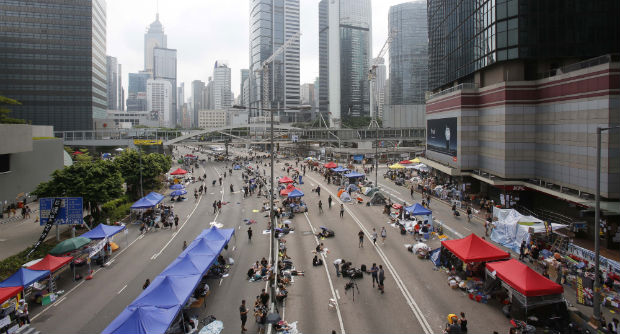
An aerial view shows a thinned crowd of pro-democracy student protesters continuing to occupy the streets around the government complex in Hong Kong, Thursday, Oct. 2, 2014. Raising the stakes in their standoff with the authorities, Hong Kong’s pro-democracy protesters threatened to occupy key government buildings unless the territory’s top official resigns by the end of the day Thursday. AP
MANILA, Philippines—Will the pro-democracy demonstrators—after several days of defiance of Hong Kong and Chinese governments’ call for them to go back home—be violently dispersed just like what Beijing did in the 1989 Tiananmen Square Massacre?
Former Department of Interior and Local Government (DILG) Secretary Rafael Alunan said during a protest rally in front of the Chinese Consular Office in Makati that they have monitored reports in social media from netizens in Hong Kong of movement from the People’s Liberation Army (PLA) of China.
He fears that the movement could be in preparation for a violent crackdown against the thousands of protesters in Hong Kong, among them Filipinos, who support the pro-democracy rally that began September 28, 2014.
“China should desist from using force to break-up the massive protest that way it did to violently crush pro-democracy student protesters in Beijing in 1989, globally known as the ‘Tiananmen Square Massacre’,” Alunan said during the rally Thursday.
“I earnestly hope Beijing won’t do a reprise in Hong Kong but with the way the Chinese government is behaving in recent times, it’s really hard to tell how far it would go to maintain control and prevent the spreading protest from reaching the mainland,” he said
The Tiananmen Square Massacre took place on June on 1989 in Beijing after several weeks of sit-in protest from as much as a million university students calling for reforms in the Communist government including freedom of the press, freedom of speech, and stamping out of corruption.
Martial law was eventually declared and the military was brought in to use force in dispersing the protesters resulting in casualties. A photograph of a lone protester standing in front of a column of tanks was taken during the Tiananmen Square incident and became an icon of the protest movement.
Since September 28, thousands of rallyists in Hong Kong have occupied major highways near government offices forcing them to close.
The protest, dubbed as the “Umbrella Revolution,” stems from China’s decision to choose can run as Chief Executive of the Hong Kong Special Administrative Region (SAR) in the 2017 elections.
The Department of Foreign Affairs (DFA), however, said that it does not see the possibility of a violent crackdown from China.
“As far as we are concerned, we have not monitored any [movement from the PLA] of that sort, there are no indications that it will lead to [a violent dispersal],” DFA spokesman Assistant Secretary Charles Jose said in a briefing.
Jose confirmed that there were Filipinos in Hong Kong who have joined in the demonstrations and admitted that there was nothing they could other than urge them repeatedly to not join.
“These are individual initiatives and it’s not the government policy. We are not commenting on what is happening in Hong Kong so as not to be misconstrued as interfering in the internal affairs of Hong Kong,” Jose said.
“It is humanly impossible to stop the Filipinos there from doing what they want to do,” he said.
RELATED STORIES
China warns of ‘chaos’ if Hong Kong protests persist
No images of Hong Kong protests in China’s media

